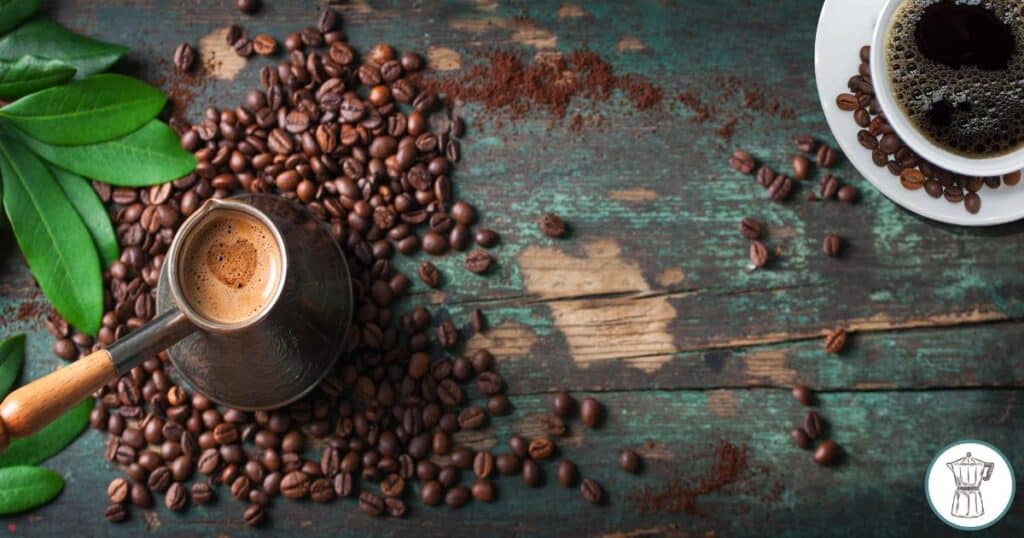I can’t think of a better combination than coffee and chocolate they’re like twins.
Many think that they both come from the same plant. The truth is that although they both grow in exotic places they come from different plants.
Let’s go over the how coffee and cacao beans grow and produced.
The main differences between coffee and cacao beans
To kick off things, let’s take a closer look at the coffee and cacao trees.
Both trees grow in exotic places with pretty similar climates.
- Rich soils, cool to warm tropical climates, and a lack of pests or diseases are all ideal for growing coffee. With production taking place throughout areas stretching across the world along the equator including Central and South American, Asia and Africa. The top coffee producers are Brazil, Vietnam and Colombia.
- Cacao trees need abundant rain, humidity and nitrogen-rich soil – simply put, they prosper in rainforests. Ivory Coast, Indonesia and Ghana are the leading cocoa producers.
- Coffee trees are up to 10 metres 32.8 ft tall (depending on the coffee variety) whereas cocoa trees grow up to 12 metres (40 ft).
- Unlike cocoa pods that normally contain between 20 and 50 seeds, cherries grown on coffee trees have only two seeds (or coffee beans) each.
- Coffee cherries have round shape and are in the size of at 6/10-inch (1.5 cm) long whilst the cocoa pods have a similar shape to melons and their length is between 10 to 35 centimetres length.
- Each tree has around 30 cocoa pods on it whereas each coffee tree has around 2,000 cherries (or 4,000 coffee beans).
- Coffee beans as well as chocolate get their taste and aroma from the process followed after harvesting them.
- Coffee beans are dried and roasted whereas cacao fruit is roasted fermented, dried ground to take the last form of chocolate
What do cacao and coffee beans taste like?
Let’s face it, no one likes raw coffee beans, they taste bitter and earthy. Fermentation and roasting is what make them taste fantastic
Roasted cacao beans taste like dark chocolate, bitter and crunchy with an intense distinct taste; if you’re big on dark chocolate odds are you’ll like the taste of roasted cacao beans.
To make milk chocolate the beans are crushed, ground and combined with sugar, delicious ingredients and spices including nuts, caramel or coconut.
Different techniques applied during roasting to give coffee beans unique taste; the roast time, temperature or even the roaster design are some of the factors coffee brands adopt to make their beans stand out.
And of course the origin and the type of the coffee beans (Robusta or Arabica) also play a key role in the taste and aroma of coffee. For example, South American coffee beans tend to be more chocolaty and nutty in taste than those from Asia or Africa.

Are chocolate and coffee related in any possible way?
Except the colour, the caffeine content (coffee has more than chocolate) and the climates grow, they don’t share any other things in common; the aroma and taste differ and even the initial use wasn’t the same:
Coffee was used as an energy drink whilst chocolate was for the upper class as a fine dessert.
Do chocolate and coffee share any other things in common?
One thing they have in common is that we have them as energy boosters; our morning cup of joe helps us kick-start the day.
On that same note, we often have chocolate due to its sugar content that also gives us more energy. Another thing is that we associate them with good experiences, such as catching up with friends or expressing love to our family or friends.
But memories can also be bad, especially with coffee if you had to drink more than ten cups in a day to finish off a tough task at work, trying to avoid being called out by the BOSS.
And with chocolate (as it is with coffee) it can be the time you stain your favourite white top with melted chocolate.
How to mix chocolate with coffee for a making delicious desserts
Here are three elements to consider when planning to create heavenly desserts with chocolate and coffee:
- Their flavours: chocolate and coffee flavours vary widely depending on the origin and the production process, so it’s wise to pair flavours of the two that are alike. For example, mixing coffee with nutty notes with chocolate that has similar taste is going to create a decadent sweet. Going for complementary flavours is another way to create delicious desserts; if your coffee is sweet, take up your sweet a notch with some spicy or salty chocolate.
- Their texture: Another key factor is texture; if the chocolate you used for your dessert is moist you can have it with either cold or hot coffee whereas if your chocolate dessert has a firmer texture it’s a good idea to have it with hot coffee for dipping.
- Their acidity: both coffee and chocolate have different levels of acidity depending on their origin and the production process. To balance the two you can mix cold coffee (low in acidity) with rich chocolate.
How to blend coffee and chocolate to create Mocha
You’ll often find on the coffee bars’ menu under the name mochaccino or moccacino or caffe mocha, they’re all different variations of coffee blended with chocolate that tastes fantastic.
To make Mocha at home you’ll need:
- 18g ground espresso
- 1 tsp drinking chocolate
- 250ml of your choice
Start by brewing your espresso that is going to be your drink’s base, add the chocolate and steer it for about a minute to make the mix smooth. Steam your milk until a thick layer of foam is created and pour it into your cup steadily and you’re good to go. You can pair your Mocha with a chocolate-based dessert including brownies or muffins, guilty pleasures that are worth having once in a while.
Top tip: In order to create a nice thick layer of foam it’s wise to go for full fat or oats milk.
Great chocolate and coffee combos
Here are a few great chocolate and coffee combos:
- Brazilian espresso with spicy (cinnamon or cardamom) dark chocolate
- Colombian espresso with a cup cake
- Guatemalan coffee with biscotti
- Blonde coffee beans for latte with brownies
- Ethiopian espresso with chocolate ice cream
- Chocolate cake with espresso powder
Let’s wrap it up
Are you craving chocolate or a cup of coffee? I don’t blame you, they are both fantastic and in fact, you can have them together because they are amazing.
FAQ
Is chocolate or espresso bad for you? Let’s go over a few burning questions on the topic.
Where do the best coffee beans come from?
I’d say Brazilian and Colombian coffees are some of the best out there with chocolate and nutty notes, but it’s a subjective topic and it depends on everyone’s personal preference.
How many different coffee bean types are there?
The two most popular coffee beans are Robusta and Arabica making up 90% of the coffee consumption around the world.
What if you dip chocolate in my coffee?
The chocolate will melt to the bottom of your cup, and odds are that your brew will taste chocolate.
Are coffee and cacao powder the same?
No they’re not, you can use coffee powder to make delicious cakes that taste like coffee while cocoa powder is often used to make ice cream and biscuits and its taste is similar to chocolate.
Does chocolate contain caffeine?
Yes, there’s caffeine in chocolate, but not nearly as much as it is in coffee.
Caffeine content in an ounce of dark chocolate is roughly 12 mg while a cup of coffee typically contains 65 to 115 mg. A milk chocolate bar has about 3 mg of caffeine, which is considerably less than dark chocolate because its cacao content is much less.
If you’re not too sensitive to caffeine, having chocolate shouldn’t be an issue.

- How to Remove Coffee Stains From Countertop The Easy Way - December 21, 2023
- Can You Reuse Coffee Grounds in French Press? Truth Inside - December 12, 2023
- Can Expired Coffee Creamer Make You Sick? 3 Ways to Find Out - December 9, 2023
